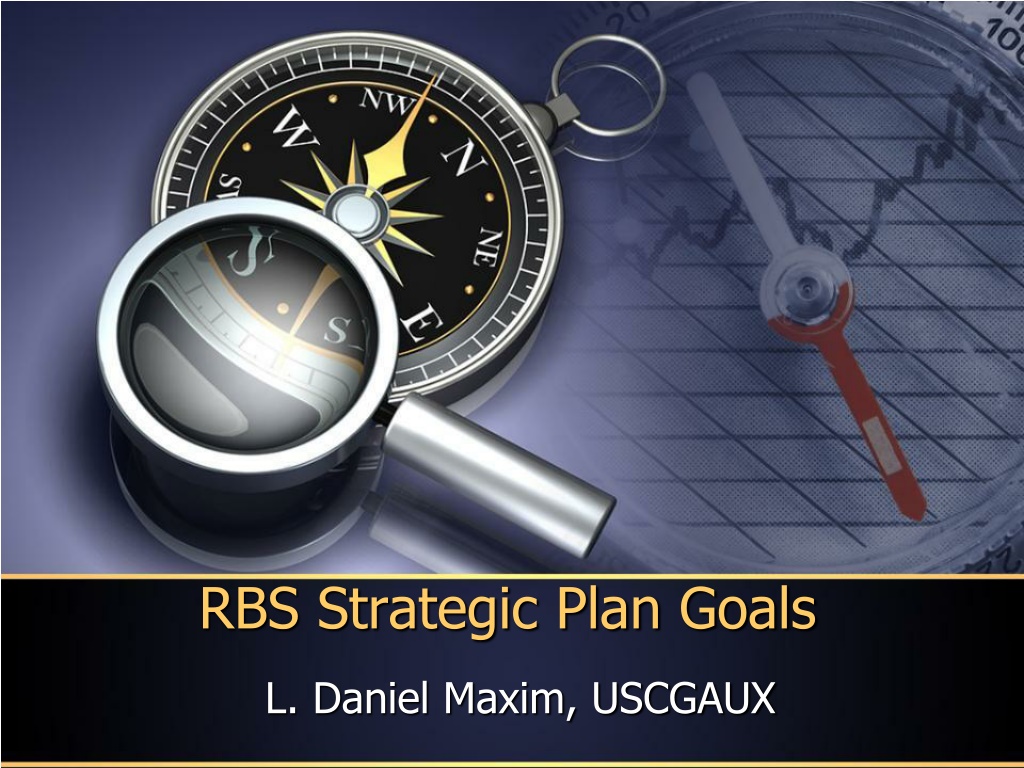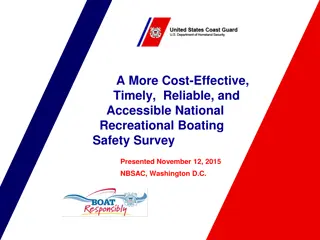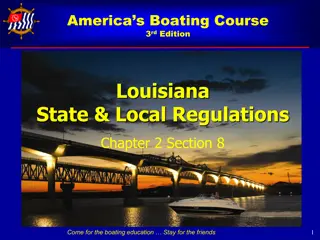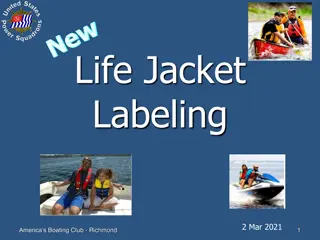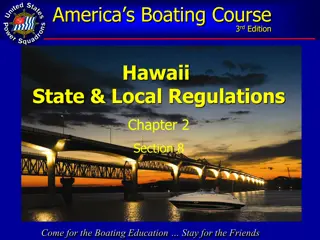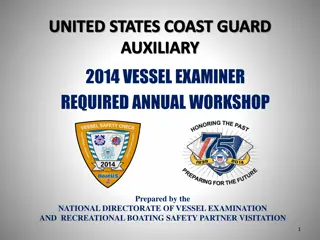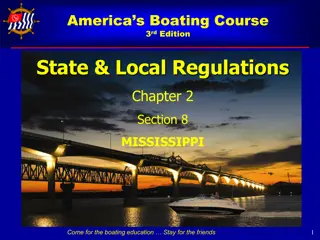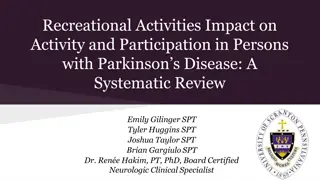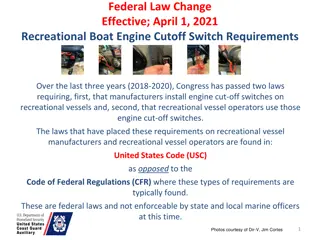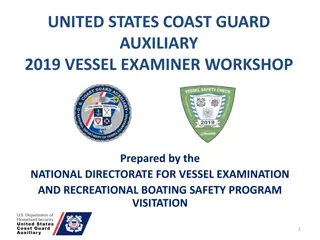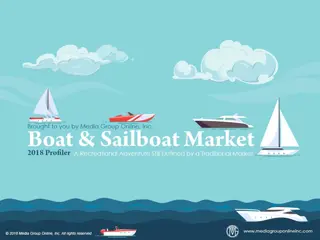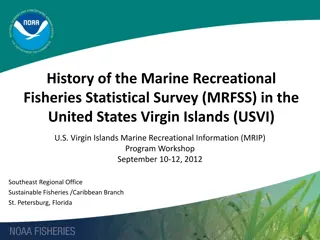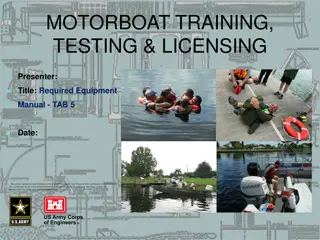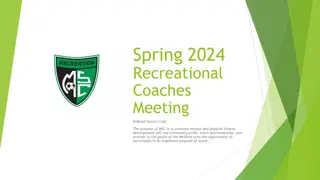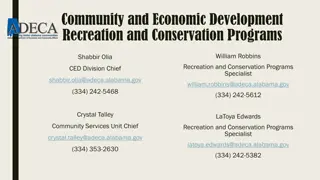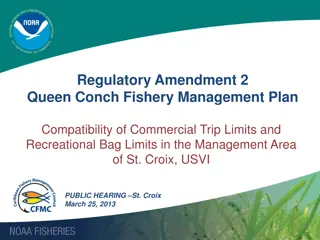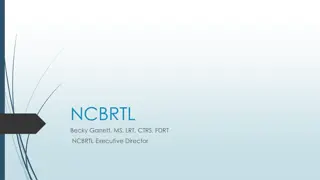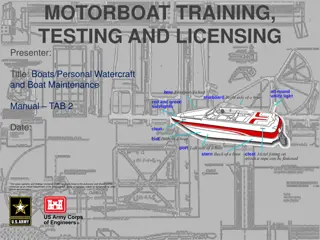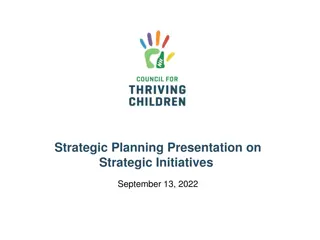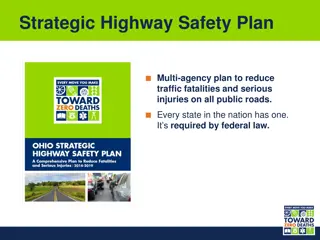Strategic Presentation on Recreational Boating Safety Goals
This presentation outlines the strategic goals and objectives pertaining to recreational boating safety, including the development of numerical targets for fatalities and injuries. It emphasizes the importance of setting specific targets, gaining stakeholder concurrence, and understanding factors influencing boating safety outcomes. While goals are essential, it acknowledges the complexities and external influences in achieving them. The presentation aims to stimulate discussion and provide background for the NBSAC members.
Download Presentation

Please find below an Image/Link to download the presentation.
The content on the website is provided AS IS for your information and personal use only. It may not be sold, licensed, or shared on other websites without obtaining consent from the author. Download presentation by click this link. If you encounter any issues during the download, it is possible that the publisher has removed the file from their server.
E N D
Presentation Transcript
RBS Strategic Plan Goals L. Daniel Maxim, USCGAUX
Goals are dreams with deadlines. Diana Sharf Hunt It is more important to know where you are going than to get there quickly. Do not mistake activity for achievement. Mabel Newcomber Do or do not. There is no try. Yoda in The Empire Strikes Back 2
Purposes of presentation Provide background and perspectives Explain how candidate numerical targets were developed for fatalities and injuries Present specific numerical fatality and injury targets for NBSAC member review Gain NBSAC concurrence or recommendation for course changes 3
Disclaimer Although the ideas included in this briefing have been informally discussed in Panel meetings, this presentation is exploratory and not an official Strategic Panel product It has not been approved by competent USCG authority It is offered to stimulate NBSAC member thought and discussion 4
Background Goals have been established in earlier plans for recreational boating fatalities, injuries, and casualties (sum of fatalities and injuries) Numerical goals for these measures are expressed as 5-year moving averages on a fiscal year basis It would be difficult (and perhaps unwise) to change either of the above conventions 6
The basic assumptions The Coast Guard and partners (hereinafter team) identify objectives and strategies (inputs) that collectively determine the outcome (output = safer boating) The team understands the linkage(s) between inputs and outcome The team has effective control over the relevant (or at least the key) inputs 7
Caution Many factors and events affect recreational boating fatalities and injuries Not all of these are under the direct control of the team (e.g., federal or state legislation, regulatory process) We are still learning about linkages As a general planning principle, we should only promise what we have a reasonable prospect of delivering 8
The best way to keep one's word is not to give it. Napoleon Bonaparte We must not promise what we ought not, lest we be called on to perform what we cannot. Abraham Lincoln 9
Perspective SMART* goals are believed best: Specific Measurable Agreed Realistic Time-based Fatalities and injuries are clearly specific, measurable, and time-based * There are various keywords associated with the SMART mnemonic 10
Perspective The operative question is whether these goals are agreed and realistic Tentative numerical casualty goals are consistent with assumptions The assumptions need to be challenged and revised if we are unsatisfied with the tentative goals 11
Perspective Because control over outputs may be limited, it is important to think carefully about the inputs The inputs in this case are the numbered objectives and implementing strategies These have will be presented to NBSAC by Panel objective leaders during this meeting 12
Perspective Therefore, it makes sense to decide whether the inputs are fundamentally correct, consistent, and coherent Given this conclusion, the numerical goals for fatalities and injuries should be realistic (achievable) We should not be accountable for outcomes we cannot control 13
Assumptions Tentative Plan is evolutionary, not revolutionary Targets should be based on extrapolation of trends as points of departure (POD) for NBSAC member review and revision These represent a surprise free projection of the future We will address step change possibilities later 15
Plan goals (again) = Fatalities + Injuries Casualties 16
Fatalities Fatality rates have declined appreciably over the years since 1960 and fatalities reduced since 1973 But progress has slowed in recent years; some believe that we are stuck in a diminishing returns situation Mathematical models have been developed that accurately replicate the time series of observed fatalities 17
Fatalities 1980 to present Gray line is plot of actual data Blue line is plot of fitted model Ft = (1 r)(t ) + F 18
Fatalities 2000 to 2016 Dashed line shows 5-yr moving average Black dots are present plan Blue line is plot of fitted annual model 19
Fatality projections These are model predictions from 2012 until 2016 Fiscal Year 5-yr moving average fatalities 668 665 661 658 655 2012 2013 2014 2015 2016 20
Injuries Reported recreational boating injuries actually increased until the year 2000 It is possible (likely?) that this is an artifact of non-response in accident reporting Reported injuries have decreased since year 2000 and projections are based on an extrapolation of this recent trend 21
Injuries 1960 to present Year-to-year data 5-yr moving average 22
Injuries 2000 to present 5-yr moving average Dashed lines show % decrease from year 2000 Dashed lines show % decrease from year 2000 23
Injury projections These are model predictions from 2012 until 2016 Fiscal Year 5-yr moving average injuries 3,295 3,212 3,132 3,054 2,997 2012 2013 2014 2015 2016 24
More on injury projections Plan includes strategies intended to increase accident reporting Success (and timing) of these strategies is uncertain Material success might invalidate assumptions on which projections are based should be reflected in text to accompany numerical goals 25
SMART goals Redux Specific Measurable Agreed Realistic Time-based 26
SMART goals As noted above, goals are consistent with USCG precedents and are specific, measurable, and time-based Based on observed trends and defined assumptions, these goals are arguably realistic, but Are they satisfactory? 27
Agreed? USCG looks to NBSAC for guidance Strategic Planning Panel has agreed with the tentative goals in principle, excluding the possibility of step change options such as mandatory life jacket wear for certain boaters Your input solicited but, if you disagree be prepared to challenge or relax assumptions on which plan is based You need not react immediately 28
Step changes Intended to be revolutionary, not evolutionary Most dramatic impact of mandatory life jacket wear will be on fatalities, not injuries Impact on fatalities depends upon specific requirements, their timing, and assumptions regarding boater compliance We do not yet have the analytical models to make this calculation, but these can be developed 29
What motivates step changes? "Some men see things as they are and say why I dream things that never were and say why not." George Bernard Shaw (also attributed to Robert F. Kennedy) If not us, who? If not now, when? John F. Kennedy (other sources also) 30
Possible questions Should we entertain step change possibilities and develop estimates of lives saved and include these in the plan? Should we signal the intent to evaluate step change options in the plan without a specific forecast of the outcome? Should we put the Strategic Plan on hold until these issues are resolved? 31
Possible questions If you knew that mandatory life jacket wear was on the table, would you recommend material changes to any of the other objectives/strategies included in the plan? If so, which? If the answer to the above question is no, then should the plan just present the business as usual projections and indicate that new projections will be made in the future? 32
The way forward This presentation is intended to identify options rather than to urge a solution Please think about the options and provide considered input later Remember that the Strategic Plan is both a plan and a contract but plans should be flexible and contracts can be renegotiated 33
Additional comments? Space reserved for your comments 34
Supplemental overheads You should take care to set goals over which you have as much control as possible - there is nothing as dispiriting as failing to achieve a goal for reasons beyond your control such as bad business environments, poor judging, bad weather, injury, or just plain bad luck. Goals based on outcomes are extremely vulnerable to failure because of things beyond your control. Source: http://www.mindtools.com/pggoalef.html. 35
Supplemental overheads If you set a plan of action and then try to rigidly adhere to it as you implement your plan, you'll often miss out on the opportunities and changes that could make your outcome far more satisfying, effortless, and rewarding. Instead of plan-and- control, learn what works and what doesn't, assimilate your discoveries, and adjust your plan as you go. [Emphasis added.] Source: http://hubpages.com/hub/Goal-Setting- Success-Strategies. 36
Supplemental overheads Goals work best if people believe they are realistic." Source: http://www.cio.com/article/501654/Goal_Setting_Ho w_CIOs_Can_Avoid_Pitfalls. The best goals are challenging enough to interest and energize us, but not so far out that we can t see ourselves ever achieving them. Source: http://creatingabetterlife.net/2009/01/07/6-goal- setting-pitfalls-to-avoid-this-year/ 37
Supplemental overheads For decades, scholars have prescribed goal setting as an all-purpose remedy for employee motivation. Rather than dispensing goal setting as a benign, over-the-counter treatment for students of management, experts need to conceptualize goal setting as a prescription-strength medication that requires careful dosing, consideration of harmful side effects, and close supervision. Source: http://www.mastersungroup.com/resources/Goals% 20Gone%20Wild.pdf. 38
More from goals gone wild article In this article, we argue that the beneficial effects of goal setting have been overstated and that systematic harm caused by goal setting has been largely ignored. We identify specific side effects associated with goal setting, including a narrow focus that neglects non-goal areas, a rise in unethical behavior, distorted risk preferences, corrosion of organizational culture, and reduced intrinsic motivation. Source: Harvard Business Review; http://www.mastersungroup.com/resources/Goals% 20Gone%20Wild.pdf. 39
